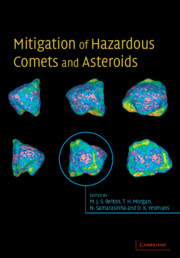Book contents
- Frontmatter
- Contents
- List of contributors
- Preface
- Acknowledgments
- Glossary
- 1 Recent progress in interpreting the nature of the near-Earth object population
- 2 Earth impactors: orbital characteristics and warning times
- 3 The role of radar in predicting and preventing asteroid and comet collisions with Earth
- 4 Interior structures for asteroids and cometary nuclei
- 5 What we know and don't know about surfaces of potentially hazardous small bodies
- 6 About deflecting asteroids and comets
- 7 Scientific requirements for understanding the near-Earth asteroid population
- 8 Physical properties of comets and asteroids inferred from fireball observations
- 9 Mitigation technologies and their requirements
- 10 Peering inside near-Earth objects with radio tomography
- 11 Seismological investigation of asteroid and comet interiors
- 12 Lander and penetrator science for near-Earth object mitigation studies
- 13 Optimal interception and deflection of Earth-approaching asteroids using low-thrust electric propulsion
- 14 Close proximity operations at small bodies: orbiting, hovering, and hopping
- 15 Mission operations in low-gravity regolith and dust
- 16 Impacts and the public: communicating the nature of the impact hazard
- 17 Towards a national program to remove the threat of hazardous NEOs
- Index
12 - Lander and penetrator science for near-Earth object mitigation studies
Published online by Cambridge University Press: 12 October 2009
- Frontmatter
- Contents
- List of contributors
- Preface
- Acknowledgments
- Glossary
- 1 Recent progress in interpreting the nature of the near-Earth object population
- 2 Earth impactors: orbital characteristics and warning times
- 3 The role of radar in predicting and preventing asteroid and comet collisions with Earth
- 4 Interior structures for asteroids and cometary nuclei
- 5 What we know and don't know about surfaces of potentially hazardous small bodies
- 6 About deflecting asteroids and comets
- 7 Scientific requirements for understanding the near-Earth asteroid population
- 8 Physical properties of comets and asteroids inferred from fireball observations
- 9 Mitigation technologies and their requirements
- 10 Peering inside near-Earth objects with radio tomography
- 11 Seismological investigation of asteroid and comet interiors
- 12 Lander and penetrator science for near-Earth object mitigation studies
- 13 Optimal interception and deflection of Earth-approaching asteroids using low-thrust electric propulsion
- 14 Close proximity operations at small bodies: orbiting, hovering, and hopping
- 15 Mission operations in low-gravity regolith and dust
- 16 Impacts and the public: communicating the nature of the impact hazard
- 17 Towards a national program to remove the threat of hazardous NEOs
- Index
Summary
Introduction
Some investigations of the surface or sub-surface of near-Earth objects (NEOs) that are needed to support mitigation demand contact with the surface. The main examples are:
Seismological methods, requiring both sources and receivers, to examine the internal structure of NEOs and look for cracks and voids that may influence the mitigation strategy and its effects.
Surface and sub-surface mechanical properties measurements, to determine the material's response to drilling, digging, hammering, impacts, explosive detonations, etc. The type of measurements performed would depend on the mechanical interaction involved in the mitigation strategy being pursued (e.g., whether low or high strain rate).
Measurements of sub-surface thermal properties and volatile content, with a view to using non-gravitational forces (outgassing) for mitigation.
Emplacement of a radio beacon to help refine predictions of a NEO's future orbit.
Radio transmission tomography, to examine the interiors of NEOs.
There are of course many other potential investigations requiring surface contact that appear to be rather less important for mitigation, being motivated wholly by science or space resources studies. For example, mitigation studies would seem to require compositional information no more detailed than that that can be determined remotely (e.g., by X-ray and infrared (IR) spectroscopy) and by comparison with meteorite analogs. An object's response to a mitigation technique is determined more directly by a set of key physical properties – particularly mechanical, thermal, and structural.
Information
- Type
- Chapter
- Information
- Mitigation of Hazardous Comets and Asteroids , pp. 266 - 291Publisher: Cambridge University PressPrint publication year: 2004
Accessibility standard: Unknown
Why this information is here
This section outlines the accessibility features of this content - including support for screen readers, full keyboard navigation and high-contrast display options. This may not be relevant for you.Accessibility Information
- 3
- Cited by
